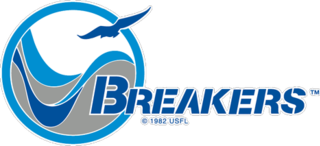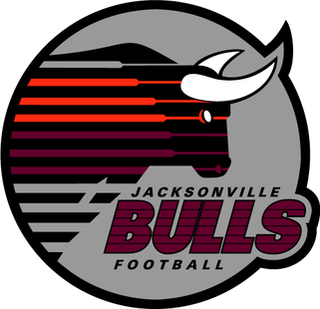
The World Football League (WFL) was an American football league that played one full season in 1974 and most of its second in 1975. Although the league's proclaimed ambition was to bring American football onto a worldwide stage, the farthest the WFL reached was placing a team – the Hawaiians – in Honolulu, Hawaii. The league folded midway through its second season, in 1975. A new minor football league began play as the World Football League in 2008 after acquiring the rights to its trademarks and intellectual property; it folded in 2011.

The United States Football League (USFL) was a professional American football league that played for three seasons, 1983 through 1985. The league played a spring/summer schedule in each of its active seasons. The 1986 season was scheduled to be played in the autumn/winter, directly competing against the long-established National Football League (NFL). However, the USFL ceased operations before that season was scheduled to begin.

The Portland Breakers were an American football team that played in the United States Football League (USFL) in the mid-1980s. Before moving to Portland, Oregon, the franchise was previously in Boston, Massachusetts as the Boston Breakers and New Orleans, Louisiana as the New Orleans Breakers.
The Philadelphia / Baltimore Stars were a professional American football team which played in the United States Football League (USFL) in the mid-1980s. Owned by real-estate magnate Myles Tanenbaum, they were the short-lived league's dominant team, playing in all three championship games and winning the latter two. They played their first two seasons in Philadelphia as the Philadelphia Stars before relocating to Baltimore, where they played as the Baltimore Stars for the USFL's final season. Coached by Jim Mora, the Stars won a league-best 41 regular season games and 7 playoff games.
The Orlando Renegades were a professional American football team that played in Orlando, Florida, in the United States Football League (USFL) for a single season in 1985. Before its season in Orlando, the franchise played in Washington, D.C., as the Washington Federals for two seasons, in 1983 and 1984.
The Michigan Panthers were a professional American football team based in the Detroit, Michigan area. The Panthers competed in the United States Football League (USFL) as a member of the Western Conference and Central Division. The team played its home games at the Pontiac Silverdome in Pontiac, Michigan.
The Oakland Invaders were a professional American football team that played in the United States Football League (USFL) from 1983 through 1985. Based in Oakland, California, they played at the Oakland–Alameda County Coliseum.
The New Jersey Generals were a franchise of the United States Football League (USFL) established in 1982 to begin play in the spring and summer of 1983. The team played three seasons from 1983 to 1985, winning 31 regular season games and losing 25 while going 0–2 in postseason competition. Home games were played at Giants Stadium in East Rutherford, New Jersey, which was called The Meadowlands for Generals games.
The Pittsburgh Maulers were a team that competed in the 1984 season of the United States Football League. Their most prominent player was first pick overall in the 1984 USFL Draft, running back Mike Rozier of Nebraska, who won the Heisman Trophy, collegiate football's most prestigious individual award.
The Memphis Showboats were an American football franchise in the United States Football League. They entered the league in its expansion in 1984 and made the 1985 playoffs, losing in the semifinal round to the Oakland Invaders. Perhaps the most prominent players on the Showboats' roster during their two seasons of existence were future Pro Football Hall of Fame member Reggie White and future professional wrestler "The Total Package" Lex Luger.
The Birmingham Stallions were a franchise in the United States Football League, an attempt to establish a second professional league of American football in the United States in competition with the National Football League. They played their home games at Birmingham, Alabama's Legion Field. They competed in all three USFL seasons, 1983–1985. During their run, they were one of the USFL's more popular teams, and seemed to have a realistic chance of being a viable venture had the USFL been better run.

The Jacksonville Bulls were a professional American football team based in Jacksonville, Florida. They were members of the United States Football League (USFL) during its final two seasons, 1984 and 1985. They played their home games in the Gator Bowl in Jacksonville.
The Denver Gold was an American football franchise in the United States Football League (USFL) from 1983 to 1985. The Gold played their home games at Mile High Stadium in Denver, Colorado; and were co-tenants in the spring with the Triple-A Denver Zephyrs baseball team.
Thomas Johnson "John" Reaves was an American professional football player who was a quarterback for 11 seasons in the National Football League (NFL) and three seasons in the United States Football League (USFL) during the 1970s and 1980s. Reaves played college football for the Florida Gators football, and earned first-team All-American honors.
On May 24, 1982, the United States Football League (USFL) reached an agreement with ABC and ESPN on television rights. The money for inaugural 1983 season would be a total of $13 million: $9 million from ABC and $4 million from ESPN.

The Tampa Bay area is home to many sports teams and has a substantial history of sporting activity. Most of the region's professional sports franchises use the name "Tampa Bay", which is the name of a body of water, not of any city. This is to emphasize that they represent the wider metropolitan area and not a particular municipality and was a tradition started by Tampa's first major sports team, the original Tampa Bay Rowdies, when they were founded in 1975.
Bret Clark is a former professional American football player. Clark played for the in-state Nebraska Cornhuskers football team, for whom he was an All-American defensive back during his senior year of 1984. After college, he played one season with the United States Football League (USFL)'s Tampa Bay Bandits, then started at safety for three seasons with the National Football League (NFL)'s Atlanta Falcons. A serious and chronic knee injury ended his professional football career in 1988.

The 1984 USFL season was the second season of the United States Football League.

The 1986 USFL season would have been the fourth season of the United States Football League. Plans and a schedule had been set for a 1986 season, which would have played in the autumn and winter months, but the failure to secure a large judgment or concessions through a landmark antitrust lawsuit against the National Football League, combined with the seizure of one of the team's assets, days before the season was to begin led the league to postpone, then ultimately cancel the season and cease operations. The federal court judgement found the NFL guilty of violating antitrust guidelines on July 29, 1986, but the USFL was only awarded $1 in damages plus court costs, as the jury found that the actions of the USFL owners had done as much in detriment to themselves as did the actions of the NFL. On August 4, the 1986 season was canceled. On August 7, all players were released from their contracts.

Bill Winters is an American former professional football offensive lineman who played in the National Football League (NFL), Canadian Football League (CFL), American Football Association (AFA), and United States Football League (USFL) for eight seasons during the 1970s and 1980s. He played college football for Princeton University, and thereafter he played professionally for the Washington Redskins and New York Giants of the NFL, the Montreal Alouettes and BC Lions of the CFL, the Orlando Americans and Carolina Storm of the AFA, and the Tampa Bay Bandits, San Antonio Gunslingers, and Portland Breakers of the USFL.






